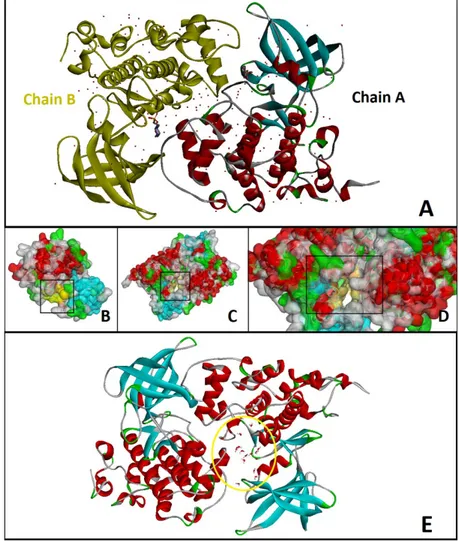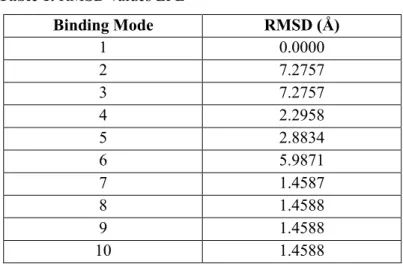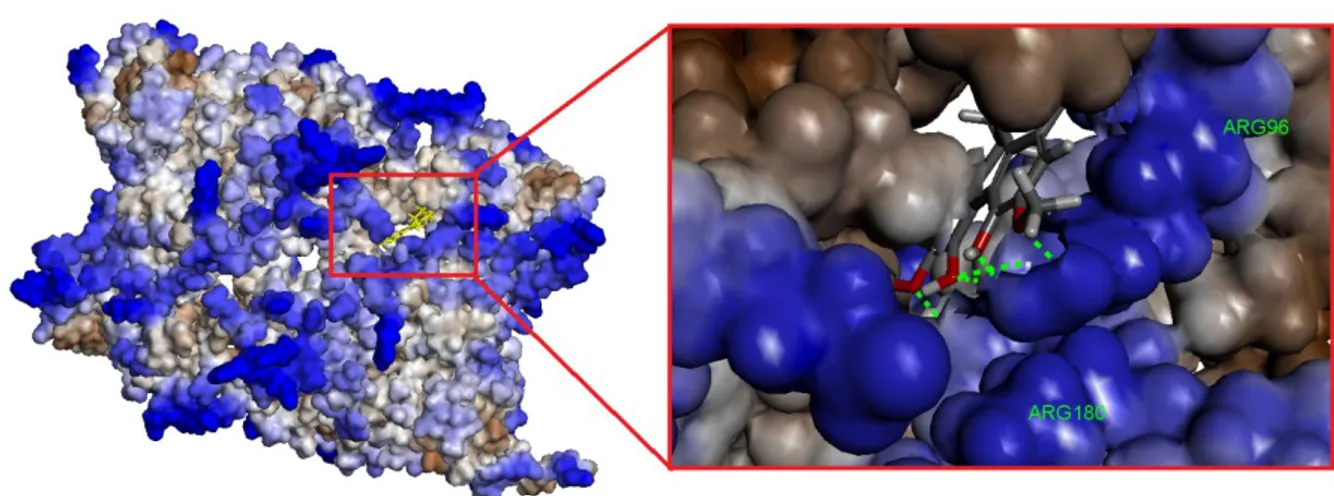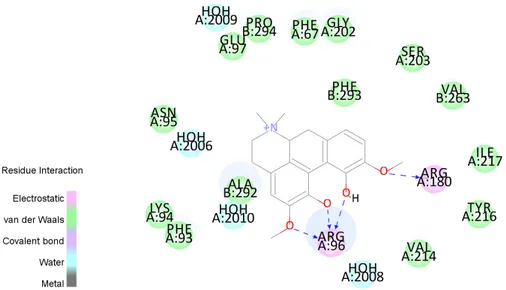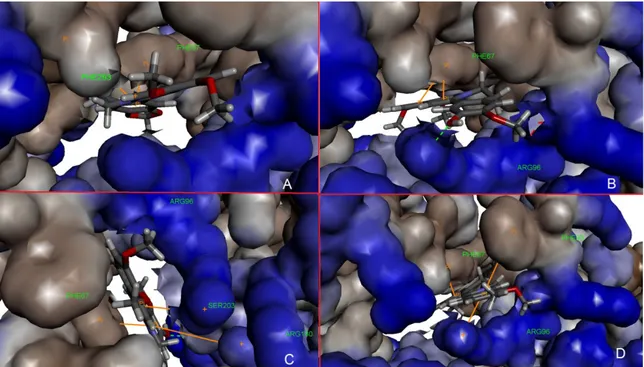ORIGINAL ARTICLE / ÖZGÜN MAKALE
MOLECULAR BINDING PROFILE OF PROTOBERBERINE
ALKALOIDS ON GLYCOGEN SYNTHASE KINASE 3β AS a DRUG
CANDIDATE FOR ALZHEIMER’S DISEASES
ALZHEİMER HASTALIĞINDA İLAÇ ADAYI OLARAK PROTOBERBERİN
ALKALOİTLERİNİN GLİKOJEN SENTAZ KİNAZ 3β İLE MOLEKÜLER BAĞLANMA
PROFİLLERİ
Gozde YALCIN
1,*, Ilkay YILDIZ
21
Biotechnology Institute, Ankara University, Ankara 06560 Turkey
2
Department of Pharmaceutical Chemistry, Faculty of Pharmacy, Ankara University, Ankara
06560 Turkey
ABSTRACT
Objective: Protoberberine alkaloids such as berberine, palmatine, jatrorrhizine, columbamine,
magnoflorine were found to prevent a progressive neurodegenerative disorder as experimentally, the mechanisms of them are not absolutely clear. In this study, we have aimed to elucidate the binding and affect mechanism of these alkaloids on the GSK-3β.
Material and Method: Glycogen Synthase Kinase 3β (GSK-3β) is a serine/threonine kinase which has
essential roles in Alzheimer’s Diseases (AD) processes. AD shows neuropathological markers as tau hyperphosphorylation and accumulation of amyloid β (Aβ) proteins. Aβ proteins are generated from sequential cleavages of amyloid precursor protein (APP). Recent studies show that inhibition of GSK-3β causes to decrease in the cleavage of APP. Thus the accumulation of Aβ was prevented by this process. Due to the therapeutic benefit of the inhibition of GSK-3β it has been a favoured target for scientists.
Alkaloids are secondary metabolites which are produced by a large variety of organisms as plants with diverse structures. To explain the binding and the effect mechanism of GSK-3β, molecular docking studies were applied on these natural products by using CDOCKER module of Discovery Studio 3.5 Client. Binding mechanism was identified by Hydrogen, π bindings between ligands and GSK-3β.
Result and Discussion: It has established that some protoberberine alkaloids with attractive properties
about inhibition of GSK-3β. The molecules exhibited <-7.0 kcal/mol binding affinity values. Best docked results
* Corresponding Author / Sorumlu Yazar:Gozde Yalcin
e-mail: gozdeyalcin@ankara.edu.tr
were detected with magnoflorine. In contrast with the other protoberberine alkaloids, magnoflorine has a compact structure. It could be more effective on binding affinity to receptor due to this reason.
Keywords: alzheimer’s disease; glycogen synthase kinase 3β; molecular docking; protoberberine alkaloid
ÖZ
Amaç: Berberin, palmatin, yatrorrizin, kolumbamin, magnoflorin gibi protoberberin alkaloitlerin
nörodejeneratif hastalıklardan koruduğu deneysel olarak tespit edilmiş olmasına rağmen; buna yol açan mekanizma tam olarak açıklanamamıştır. Bu çalışmada, bu alkaloitlerin GSK-3β ile bağlanma ve etki mekanizmalarını açığa kavuşturmak hedeflenmiştir.
Gereç ve Yöntem: Glikojen Sentaz Kinaz 3β (GSK-3β) Alzheimer Hastalığına (AD) ait süreçlerde
vazgeçilmez öneme sahip bir serin/treonin kinazdır. Alzheimer Hastalığı tau hiperfosforilasyonu ve amiloid β (Aβ) proteinlerin birikimi gibi nöropatolojik belirteçler göstermektedir. Aβ proteinleri Amiloid Öncül Protein (APP)’nin sekanssal kesimi ile meydana gelmektedir. Son dönemlerdeki çalışmalar GSK-3β inhibisyonunun APP kesiminde gerilemeye yol açtığını ortaya koymuştur. Böylece Aβ birikimi bu proses ile önlenmektedir. GSK-3β inhibisyonunun terapötik önemi nedeniyle Bilim insanları için önemli bir hedef haline gelmiştir. Alkaloidler çeşitli yapılardaki bitkiler gibi pek çok organizma tarafından üretilen sekonder metabolitlerdir. Alkaloitlerin GSK-3β ile bağlanma ve etki mekanizmalarını açığa kavuşturmak amacıyla; bu doğal ürünlerle, Discovery Studio 3.5 Client programına ait CDOCKER modulü kullanılarak moleküler doking çalışmaları yürütülmüştür. GSK-3β ile ligandlar arasındaki bağlanma mekanizması Hidrojen ve π bağları vasıtasıyla tespit edilmiştir.
Sonuç ve Tartışma: Dikkat çekici özellikleriyle bazı protoberberin alkaloitlerinin GSK-3β inhibisyonu
üzerindeki etkileri incelenmiştir. Moleküller -7.0 kcal/mol’den küçük bir bağlanma afinitesi göstermiştir. En iyi doking sonuçları magnoflorinden elde edilmiştir. Diğer protoberberin alkaloitlerinin aksine magnoflorin daha kompakt bir yapıya sahiptir. Bu özelliğinin reseptöre bağlanma kapasitesinin arttırılmasında etkili olabileceği düşünülmüştür.
Anahtar Kelimeler: alzheimer hastalığı; glikojen sentaz kinaz 3β; moleküler doking; protoberberin
alkaloitleri
INTRODUCTON
Alzheimer’s disease (AD) is an irreversible, progressive neurodegenerative disease that causes memory lose and decreasing of cognitive skills. In most people with Alzheimer’s, symptoms first appear in their mid-60s. Alzheimer's disease is currently ranked as the third leading cause of death for older people in the United States, just behind heart disease and cancer [1].
AD is very complex and just one drug is not being enough to treatment of disease. Current approaches mainly focus on increasing of mental function, managing of behavioral symptoms, and slow down certain problems, such as memory loss. It is getting importance to understand the underlying reasons of disease and developing new multi-target drug molecules.
AD has been caused by the troubles which evolve in several mechanisms and shows itself with some neuropathological markers as neurofibrillary tangles with tau hyperphosphorylation and accumulation of amyloid β (Aβ) proteins (Figure 1)[2].
Figure 1. Neuropathological markers of AD [2]
Sequential proteolysis of amyloid precursor protein (APP) causes generation of Aβ proteins. APP is a transmembrane protein which is highly expressed in brain tissues and concentrated in the synapses of neurons. An α-secretase, β-secretase, and the intramembranous γ-secretase complex perform a sequential process to APP (Figure 2) [3].
β-secretase 1 (BACE1) is the key enzyme in the β-cleavage of APP protein (Figure 2). Inhibition of BACE1 prevents the generation of Aβ proteins. Glycogen Synthase Kinase 3β is a proline-directed serin/threonine protein kinase which mediates glycogen metabolism. Ly et al. examined the effects of
GSK-3β-specific inhibition on AD neuropathology and found specific inhibition of GSK-3β reduced
BACE1-mediated cleavage of APP [4]. In the recent studies BACE1 inhibitor design was scrapped, due to the constraints of the active site [5]. As a result of this, drug design on GSK-3β inhibition gain
importance as a drug target.
The protoberberine alkaloids found in the Berberidaceae and Ranunculaceae families. Berberidaceae family which contains 18 genera of flowering plants commonly called the barberry family [6]. The protoberberine alkaloids found the several species such as Berberis vulgaris L., B. aristata DC., B. crataegina DC., Mahonia aquifolium (Pursh) Nutt., Hydrastis canadensis L., Xanthorhiza simplicissima, Marshall Phellodendron amurense Rupr., Coptis chinensis Franch., Tinospora cordifolia (Thunb.) Miers, Argemone mexicana L. and Eschscholzia californica Cham. [7-10]. The species include trees, shrubs and perennial herbaceous plants. There are four Berberis sp. in Turkey. B. crataegina DC. and its hybrids are widespread and the fruits are often used as food [11].
The protoberberine alkaloids include a tetracyclic ring system, and they are derived from benzylisoquinolines through phenolic oxidation and coupling with the isoquinoline N-methyl group, which becomes the ‘‘berberine bridge’’ carbon [12]. The most commonly found protoberberines are: berberine, palmatine, jatrorrhizine, columbamine, magnoflorine. It was observed that protoberberine alkaloids show very important biological activities on different specific organic systems. Activities such as analgesic, anticonvulsant, antiamnesic, narcotic, antiarrhythmic, antihemorrhagic, hypotensive, antiinflammatory, antioxidant, antitumoral, antidiarrhetic, antiulcer [12]. In recent studies Protoberberine alkaloids were found to prevent a progressive neurodegenerative disorder as experimentally however the effect mechanism wasn’t explained clearly [13].
In this study, we have aimed to elucidate the binding and affect mechanism of these alkaloids on the GSK-3β. For this purpose, molecular docking studies were applied for these natural products by
using CDOCKER [14] module of Discovery Studio 3.5 Client [15]. Binding mechanism was identified by Hydrogen, π interactions between ligands and GSK-3β.
MATERIAL AND METHOD
The atomic coordinates of GSK-3β from human have been deposited in the Protein Data Bank
(www.rcsb.org; PDB accession no. 1H8F [16]) (Figure 3). GSK-3β was co-crystallized with an inhibitor
of receptor, EPE, 4-(2-Hydroxyethyl)-1-Piperazine Ethanesulfonic Acid molecule. Binding pocket of
GSK-3β was defined with key residues like PHE67, PHE93, ARG96, ARG180, ASP200, ASN213,
Receptor crystallized in dimer form (Figure 3A). Receptor was used in dimer form for docking protocol owing to binding pocket is in the outer surface of subunits (chain A or B) (Figure 3B-D). All the other heteroatom’s except water molecules in active site (i.e., nonreceptor atoms such as redundant water molecules, ions, co-crystallized ligand, etc.,) were also removed (Figure 3E). For the preparation of receptor to docking hydrogens were added and their positions were optimized using the all atom CHARMm force field and Adopted Basis set Newton Raphson (ABNR) method available in Discovery Studio 3.5 Client [15] (Figure 3E). The binding sphere was selected around the inhibitor EPE using the binding site tools.
Figure 3. 3D structure of GSK-3β. A) Whole structure with all heteroatoms. B) Active site in Chain A.
Yellow labeled surface in black square show interested area. C-D) Active site (binding pocket) between two subunits. E) Form of GSK-3β prepared to docking
All protoberberine alkaloids (Figure 4) were sketched; CHARMm forcefield parameterization was assigned to all atoms, and then minimized using the ABNR method. Molecular dynamics (MD) approach was used for conformational searches. The ligand was heated to a temperature of 700K and then annealed to 200K.
Berberine Magnoflorine O O O O O O O O N N++ H H H H HH H H H H H H H H H H H H H H HH H H H H H H H H HH H H H H H H H H Columbamine Jatrorrhizine Palmatine Figure 4. 2D structures of protoberberine alkaloids
CDOCKER [14] method was performed by using Discovery Studio 3.5 Client (DSC). EPE was firstly docked and RMSD values were calculated on the purpose of fixing a docking protocol and binding site.
RESULT AND DISCUSSION
EPE, known inhibitor of GSK-3β, was firstly examined for the comparison between the
inhibitor and protoberberine alkaloids by DSC. Docking sphere was chosen as 24,967, 15,929, 25,595 (X, Y, Z coordinates respectively) and 6,66201 radius value. CDOCKER, CHARMm based molecular docking method, was used as docking protocol. Also in situ ligand minimization was implemented by ABNR algorithm. Binding values of conformations were calculated with Generalized Born using Molecular Volume (GBMV), implicit solvent, model. RMSD values of EPE were given in Table 1.
O O O O N+ H H H H H H H H H H H H H H H H H H O O O O N+ abs H H H H H H H H H H H H H H H H H H H H H H H H O O O O N+ H H H H H H H H H H H H H H H H H H H H O O O O N+ H H H H H H H H H H H H H H H H H H H H H H
Table 1. RMSD values EPE Binding Mode RMSD (Å) 1 0.0000 2 7.2757 3 7.2757 4 2.2958 5 2.8834 6 5.9871 7 1.4587 8 1.4588 9 1.4588 10 1.4588
The predicted conformation of docking result was same with crystal structure in reliable RMSD values (~3Å). Superposition of crystallized form and docking result of EPE was shown in Figure 5.
Figure 5. Superposition of crystallized form and docking result of EPE (RMSD value=1.4587 Å).
Crystallized form was shown in yellow color.
EPE’s docking profile in binding pocket was found similar with literature [16] (Figure 6).
Protoberberine alkaloids were also docked by the same protocol with same sphere attributes. CDOCKER results were given for each ligand in Table 2.
Table 2. Binding properties of protoberberine alkaloids
Compound Binding mode Binding Enegy -CDOCKER Interaction Energy
Berberine 5 -7,43364 26,4198 Magnoflorine 1 -18,2533 34,2943 Columbamine 7 -11,988 31,9855 Jatrorrhizine 1 -12,1812 31,8892 Palmatine 1 -10,6678 30,9308 EPE 9 -6,94096 33,3915
Magnoflorine was found most effective compound with its highest binding affinity and -CDOCKER Interaction Energy. Interaction between residues and magnoflorine was shown in Figure 7-9.
Figure 7. Molecular surface of GSK-3β with magnoflorine. Hydrophobic structure of the binding
pocket. Blue residues show especially hydrophilic residues. Interaction profile between ligand and
Figure 8. 2D demonstration of interaction profile of magnoflorine. Blue discrete lines show hydrogen
bonds (with ARG96, ARG180).
Figure 9. Interactions between magnoflorine was showed more detailed. Green discreet lines shows
hydrogen bonds. Pink discreet lines shows the “bumps (close contacts)” between ligand and VAL214.
Figure 10. Protoberberine alkaloids in binding pocket. A) berberine b) columbamine c) jatrorrhizine
d) palmatine. Blue discrete lines show hydrogen bonds, orange lines show π-π interactions.
Figure 11. Protoberberine alkaloids in binding pocket with 3D structure of receptor. A) berberine b)
columbamine c) jatrorrhizine d) palmatine. Green discrete lines show hydrogen bonds, orange lines show π-π interactions.
In this work, we have established some Protoberberine alkaloids with attractive properties about inhibition of GSK-3β. The molecules exhibited <-7.0 kcal/mol binding affinity values.
Best docked results were detected with Magnoflorine. In contrast with the other protoberberine alkaloids, magnoflorine has a compact structure. It could be more effective on binding affinity to receptor due to this reason. Experimental studies between magnoflorine and GSK-3β, couldn’t find in
the literature however magnoflorine was found to cross blood-brain barrier and it was found effective on the locomotor activity of mices [17]. It was thought that this effect could provide by the inhibition of GSK-3β.
ARG96 and ARG180 were found essential for binding as literature [16]. Also PHE67, PHE93 and PHE293 residues which are in the binding pocket of GSK-3β were found interacting with
compounds as well. On the other hand water molecules weren’t found effective on binding of compounds.
REFERENCES
1. National Institute of Aging. (2016). Alzheimer’s Disease Fact Sheet. National Library of Medicine, Retrieved April 12, 2018, from https://www.nia.nih.gov/health/alzheimers-disease-fact-sheet 2. Namrata, C. (2012). Case Study-Alzheimer’s Disease. Biochemistry for Medics. Retrieved April
12, 2018, from http://www.namrata.co/case-study-alzheimer-disease/
3. Zhang, Y., Thompson, R., Zhang, H., Xu, H. (2011). APP processing in Alzheimer’s disease. Mol. Brain, 4, 3. Retrieved April 12, 2018, from http://www.molecularbrain.com/content/4/1/3
4. Ly, P.T.T., Wu,Y., Zou, H., Wang, R., Zhou, W., Kinoshita, A., Zhang, M., Yang, Y., Cai, F., Woodgett, J., Song, W. (2013). Inhibition of GSK3β-mediated BACE1 expression reduces Alzheimer-associated phenotypes. Journal of Clinical Investigation, 123, 224-235.
5. Singh, S., Kushwah, A.S., Singh, R., Farswan, M., Kaur, R. (2012). Current therapeutic strategy in Alzheimer’s disease. European Review for Medical and Pharmacological Sciences, 16, 1651-1664. 6. Grycová, L., Dostál, J., Marek, R. (2007). Quaternary protoberberine alkaloids. Phytochemistry,
68(2), 150-175.
7. Kamath, S., Skeels, M., Pai, A. (2009). Significant differences in alkaloid content of Coptis chinensis (Huanglian), from its related American species. Chinese Medical Journal, 4, 17.
8. Sarma, N.D., Koul, S., Khosa, R.L. (2009). Alkaloids from Tinospora cordifolia miers. Journal of Pharmaceutical Sciences and Research, 1(1), 26-27.
9. He, S.M., Liang, Y.L., Cong, K.,Chen, G., Zhao, X., Zhao, Q.M., Zhang, J.J., Wang, X., Dong, Y., Yang, J.L., Zhang, G.H., Qian, Z.L., Fan, W., Yang, S.C. (2018) Identification and Characterization of Genes Involved in Benzylisoquinoline Alkaloid Biosynthesis in Coptis Species. Frontiers in Plant Science, 9, 1-13.
10. Inbaraj, J.J., Kukielczak, B.M., Bilski, P., Sandvik, S.L., Chignell, C.F. (2011). Photochemistry and Photocytotoxicity of Alkaloids from Goldenseal ( Hydrastis canadensis L. ). Chemical Research in
Toxicology, 14(11), 1529-1534.
11. Sonmezdag, A.S., Kelebek, H., Selli, S. (2018). Volatile and key odourant compounds of Turkish Berberis crataegina fruit using GC-MS-Olfactometry. Natural Product Research, 32(7), 777-781. 12. Leitao da-Cunha, E.V., Fechine, I.M., Guedes, D.N., Barbosa-Filho, J.M., Sobral da Silva, M.
(2005). Protoberberine Alkaloids. The Alkaloids: Chemistry and Biology, 62, 1-75.
13. Cai, Z., Wang, C., Yang, W. (2016). Role of berberine in Alzheimer’s disease. Neuropsychiatric Disease and Treatment, 12, 2509-2520.
14. Wu, G., Robertson, D.H., Brooks, C.L., Vieth, M. (2003). Detailed analysis of grid-based molecular docking: A case study of CDOCKER - A CHARMm based MD docking program. Journal of Computational Chemistry, 24, 1549-1562.
15. Accelrys Software Inc. Discovery Studio 3.5 Client. San Diego: Accelrys Inc.; 2012.
16. Dajani, R., Fraser, E., Roe, S.M., Young, N., Good, V., Dale, T.C., Pearl, L.H. (2001). Crystal structure of glycogen synthase kinase 3 beta: structural basis for phosphate-primed substrate specificity and autoinhibition. Cell, 105, 721-732.
17. Kukula-Koch, W., Kruk-Słomka, M., Stępnik, K., Szalak, R., Biała, G. (2017). The evaluation of pro-cognitive and antiamnestic properties of berberine and magnoflorine isolated from barberry species by Centrifugal Partition Chromatography (CPC), in relation to QSAR modelling. International Journal of Molecular Sciences, 18, 2511.
![Figure 1. Neuropathological markers of AD [2]](https://thumb-eu.123doks.com/thumbv2/9libnet/3851228.35354/3.892.260.637.123.376/figure-neuropathological-markers-of-ad.webp)
